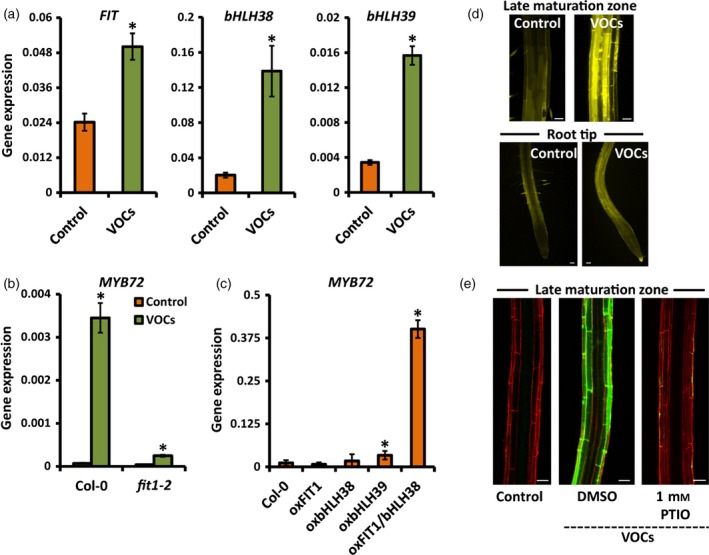Figure 6.

Bacterial VOC‐mediated induction of iron‐uptake responses in Arabidopsis roots depends on FIT and NO.
(a) Quantitative RT‐PCR analysis of FIT,bHLH38 and bHLH39 transcript levels in the roots of mock‐treated (control) and P. simiae WCS417 VOC‐treated Arabidopsis Col‐0 seedlings that were grown with sufficient iron (50 μm Fe(III)EDTA).
(b) MYB72 expression levels in the roots of mock‐treated (control) and WCS417 VOC‐treated wild‐type Col‐0 and mutant fit1‐2 seedlings that were grown with sufficient iron.
(c) MYB72 transcript levels in the roots of Col‐0 and transgenic lines over‐expressing FIT (oxFIT), bHLH38 (oxbHLH38), bHLH39 (oxbHLH39), or FIT and bHLH38 (oxFIT/bHLH38) under standard conditions (sufficient Fe, no VOCs).
(d) NO accumulation in the late maturation zone and root tip of mock‐treated (control) and VOC‐treated seedlings visualized by DAF‐FMDA fluorescence. Scale bars = 50 μm.
(e) Representative confocal images of pMYB72:GFP‐GUS roots that were either mock‐treated (control) or treated with WCS417 VOCs in the absence or presence of the NO scavenger PTIO. Scale bars = 50 μm.
Seedlings were treated with VOCs in a two‐compartment plate assay when 12 days old. Samples for quantitative RT‐PCR analysis and microscopy were collected 2 days after VOC treatment. Values in (a–c) are means ± SD of three replicates. Gene expression was normalized to that of ACTIN7. Asterisks indicate statistically significant differences compared to mock‐treated roots (Student's t test; P < 0.05).
